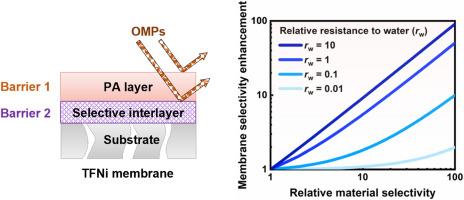Direct effects of interlayer on organic micropollutants removal by thin-film nanocomposite membranes
IF 9
1区 工程技术
Q1 ENGINEERING, CHEMICAL
引用次数: 0
Abstract
The enhanced rejection of organic micropollutants (OMPs) by the interlayered thin-film nanocomposite (TFNi) membranes is commonly attributed to the polyamide layer, which is better formed under the influence of an interlayer. However, the role of the interlayer in directly serving as a barrier layer to OMPs is seldom reported. To investigate such direct effects, we adopted iron-tannic acid (Fe-TA) complex as a model interlayer targeting OMPs removal, and prepared identical polyamide nanofilms for both the control and TFNi membranes at a support-free interface to minimize the impact of interlayer on the polyamide formation. The experimental result shows that, although at the expense of sacrificing water permeance, the interlayer can directly serve as a barrier layer to some OMPs, especially those that cannot be easily removed by the polyamide layer alone, due to the inherent hotspot of polyamide material. A theoretical analysis further suggests that, to enhance the OMPs removal by exerting such direct effects, an ideal interlayer should be more intrinsically selective to OMPs and meanwhile impose moderate resistance to water compared with the polyamide layer. This work may provide insight into the role of interlayers in removing OMPs by TFNi membranes and enlighten the fit-for-purpose design of high-performance membranes toward environmental applications.

中间层对薄膜纳米复合膜去除有机微污染物的直接影响
层间薄膜纳米复合材料(TFNi)膜对有机微污染物(OMPs)的抑制作用增强通常归因于聚酰胺层,聚酰胺层在层间层的影响下更好地形成。然而,中间层直接作为omp的屏障层的作用很少被报道。为了研究这种直接影响,我们采用铁单宁酸(Fe-TA)配合物作为去除OMPs的模型夹层,并在无支撑界面上为对照膜和TFNi膜制备了相同的聚酰胺纳米膜,以尽量减少夹层对聚酰胺形成的影响。实验结果表明,虽然以牺牲透水性为代价,但由于聚酰胺材料的固有热点,中间层可以直接作为一些omp的阻隔层,特别是那些不易被聚酰胺层单独去除的omp。理论分析进一步表明,为了通过施加这种直接效应来增强对OMPs的去除,理想的中间层应该对OMPs具有更强的内在选择性,同时与聚酰胺层相比,具有适度的耐水性。这项工作可以深入了解TFNi膜在去除omp中的作用,并为高性能膜的环境应用设计提供启发。
本文章由计算机程序翻译,如有差异,请以英文原文为准。
求助全文
约1分钟内获得全文
求助全文
来源期刊

Journal of Membrane Science
工程技术-高分子科学
CiteScore
17.10
自引率
17.90%
发文量
1031
审稿时长
2.5 months
期刊介绍:
The Journal of Membrane Science is a publication that focuses on membrane systems and is aimed at academic and industrial chemists, chemical engineers, materials scientists, and membranologists. It publishes original research and reviews on various aspects of membrane transport, membrane formation/structure, fouling, module/process design, and processes/applications. The journal primarily focuses on the structure, function, and performance of non-biological membranes but also includes papers that relate to biological membranes. The Journal of Membrane Science publishes Full Text Papers, State-of-the-Art Reviews, Letters to the Editor, and Perspectives.
 求助内容:
求助内容: 应助结果提醒方式:
应助结果提醒方式:


